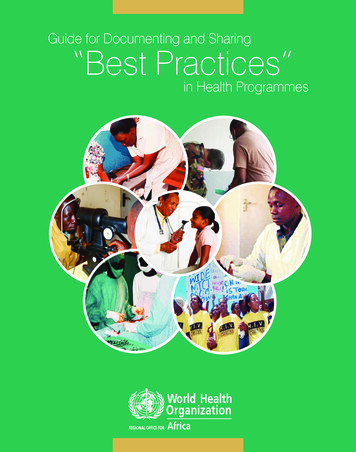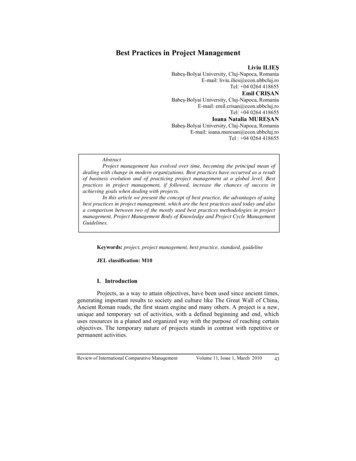
Transcription
VECAPCODEOF BESTPRACTICE
2·VECAP: CODE OF BEST PRACTICECONTENTSINTRODUCTION3THE VECAP CODE OF GOOD PRACTICE4A CODE FOR MANUFACTURERS, DISTRIBUTORSAND PROCESSORS OF POLYMER ADDITIVES5POTENTIAL SOURCES OF POLYMER ADDITIVE EMISSIONS6GENERAL PRINCIPLES FOR HANDLING POLYMER ADDITIVES81. POLYMER ADDITIVES BEST PRACTICE:TRANSPORT AND STORAGE112. POLYMER ADDITIVES BEST PRACTICE:OPENING AND EMPTYING BAGS AND BULK CONTAINERS123. POLYMER ADDITIVES BEST PRACTICE:VENTILATION184. POLYMER ADDITIVES BEST PRACTICE:OPERATIONAL PROCESS EFFICIENCY TO REDUCE WASTE AND EMISSIONSOVERVIEW OF BEST PRACTICES2022
3·INTRODUCTIONMany materials – particularly plastics - benefit from the inclusion ofspeciality chemicals during manufacture. Known collectively as ‘polymeradditives’ these can help the plastic achieve the desired physical andchemical properties needed for the end use.Polymer additives are widely used in plastics that are likely to undergoextended long-term use, for example in cars, televisions or furniture. Usingflame retardants additives increases the fire resistance properties of plastics,an important safety aid in applications such as electronics, automotivecomponents and insulation. Other additives can, for example, improveresistance to ultraviolet light, which can discolour and even degrade manyplastics. However, the additives that make these qualities possible need to behandled with care to avoid them finding their way into the environment.In 2004, BSEF – the International Bromine industry initiated a successfulproduct stewardship programme involving its member companies and theirdownstream value chain. This initiative - the Voluntary Emissions ControlAction Programme (VECAP) focused on the responsible managementof flame-retardant chemicals by downstream users where they apply orincorporate such additives into a range of materials and products includingtextiles and polymers.The original VECAP programme has had a remarkable impact on theresponsible management of brominated flame retardants within the valuechain. It has helped users to understand how to manage these additivesappropriately and responsibly by reducing environmental emissions fromtheir operations.This updated Code of Best Practice is designed to update and refreshthe key best practices for the handling and management of brominatedflame retardant additives by downstream users, in particular compoundersand master batchers so as to minimise releases to the environment andexposure of workers. The use and application of the revised Code will beactively encouraged by BSEF via key downstream use sectors associationsand other value chain actors such as specifiers (e.g. retailers) and OEMs.
4·VECAP: CODE OF BEST PRACTICETHE VECAP CODEOF GOOD PRACTICEVECAP is based on a Code of Best Practice to help producers anddownstream users – particularly compounders, textile formulators andmasterbatchers1 within the plastics converters sector - control, reduceand continuously improve their potential emissions of flame retardants.Adherence to the code is recognised as best practice in preparingChemical Safety Assessments (CSAs); so much so that the EuropeanChemicals Agency has included the additional use map for the plasticsconverters sector – EuPC - in its library2. This specifically encouragespotential registrants to implement the guidance given by the VECAP code.This Code has now been updated and is being made available widelyto industries and users of brominated flame retardants to ensure thatunintended emissions of brominated flame retardants are minimised,thereby enhancing environmental protection.As the name implies, VECAP is voluntary. However, those companiesadopting the VECAP principles are showing their commitment andresponsibility in minimising the risk of emissions and in continuouslyimproving their environmental performance.Since its establishment in 2004, VECAP in Europe has encouraged morethan 300 total downstream users’ production sites to adopt the practicesset out in the code. It has also been disseminated and applied in otherjurisdictions including Japan, Mexico, China, South Korea and Taiwan.1. Compounders mix different ingredients with polymer resins to provide specific properties. A masterbatch is a concentrated mixtureof pigments and/or additives encapsulated during a heat process into a carrier resin that is then cooled and cut into a granular shape.2. Reference to be added with link to ECHA website
5·A CODE FOR MANUFACTURERS,DISTRIBUTORS ANDPROCESSORS OFPOLYMER ADDITIVESVECAP is part of the commitment of BSEF and its member companies tothe highest standards of product stewardship3. This guide will assist andadvise polymer additive users on the best way to handle and process flameretardant additives with a view to minimising any environmental releases.This guide provides information on the Best Available Techniques and BestPractices for emptying bags and handling waste with polymer additives.This is in addition to any existing regional and global legal requirements forthe handling and use of brominated flame retardant additives, includingspecific provisions set out in particular substance safety data sheets (SDSs).3. The original VECAP Code of Practice was developed jointly in 2004 by the BSEF and the British Textile Finishers Association (TFA)and jointly promoted with the European Flame Retardants Associations (EFRA)
6·VECAP: CODE OF BEST PRACTICEPOTENTIAL SOURCES OFPOLYMER ADDITIVE EMISSIONSPolymer additives can be unintentionally released to the air, water and landif effective steps are not taken to identify and minimise the likelihood of suchemissions. This section highlights the major emission source categories andthe potential sources.LANDAIRWATERLAND EMISSIONSOperational uses of polymer additives may result in land emissions.The following are particular sources of emissions: Product residues in empty packaging Spills and floor sweepings Contaminated/off-specification products Test specimens/quality control samples Dust filter residues Sludge from waste water treatment (WWT) Selling discharged big bags or intermediate bulk containers (IBCs)without knowing what treatment the end user has used to removeany residual products. Cleaning packaging; for example, during preparation for reuse or recycling.Land emissions from residual products in empty packaging represent thelargest component of overall potential emissions.
7·AIR EMISSIONSWhen handling powdered materials, such as in packaging lines or insystems for loading reactor vessels, it is essential to use a local exhaustventilation system whenever possible when emptying polymer additivespackaging; this will minimise dust emissions.Equipping ventilation systems with adequate filters can reduce air emissionsby up to 99 percent. In addition, closing any windows or doors located nearventilation systems will help avoid interference with the exhaust system.Avoiding outdoor storage of empty packaging in open containers will alsoreduce risk.WATER EMISSIONSWater-based dispersions of polymer additives requires special measures intheir processes to prevent environmental releases.Any water used during processing and cleaning should be kept completelyseparate from rainwater to avoid it entering water streams untreated.Washing re-usable protective clothing in cleaning facilities outside the plantwhere BFRs are handled should be avoided.OTHER EMISSIONS - REDUCTION OPPORTUNITIESNon-reusable samples/off-specification material should be collected,stored if possible, then disposed of as chemical waste once testing hasbeen completed.
8·VECAP: CODE OF BEST PRACTICEGENERAL PRINCIPLES FORHANDLING POLYMER ADDITIVESDuring manufacturing, multiple transfers or blending operations may occurbefore final processing. When processed, base resins encapsulate the polymeradditive or, in some cases, react with the additive to form the desired plastic.However, powdered polymer additives can stick to packaging andprocessing equipment. This creates a risk of airborne dust during transferprocesses. Similarly, water-based production processes pose a high risk ofwaterborne emissions.These potential risks underline why it is essential to have effective preventativemeasures in place for identifying and minimising any potential emissions.SAFETY DATA SHEETSPolymer additive producers are legally required to keep their Safety DataSheets (SDSs) for brominated flame retardant additives they place on themarket up-to-date. They are also required to inform customers of any updates.SDSs can be requested via the producers’ websites or downloaded mGOOD HOUSEKEEPINGFormal cleaning procedures and effective industrial hygiene should be partof any manufacturing sites operating procedures. The procedures put inplace should reflect any requirements set out in additive safety data sheetsto minimise worker exposure and potential release to the environment.These procedures should be monitored and controlled to maintain thehighest standards. Employees should be trained to clean work areasfrequently, regularly and thoroughly. Key recommended actions:
9· All employees should have access to guidelines for good housekeepingand have regular training scheduled. Polymer additive packaging should be clearly marked as such andkept in designated closed containers, ideally in a separate designatedclosed container. This should also apply to residue from spills, unusablesamples, off-spec material and any dust collected. Employees handling polymer additives should wear appropriateprotective clothing. They should also know how to dispose ofcontaminated clothes appropriately. Spent packaging with polymer additive residues should be reused wherepracticable. If not, the packaging should be disposed of in the same way aspolymer additives’ waste, i.e. sent to an approved chemical waste incinerator.BEST PRACTICE:This guide also provides more detailed information on important potentialsources of emissions and the current best practices in:1. Storage2. Opening and Emptying Bags and Bulk Containers;3. Ventilation;4. Operational Process Efficiency to Reduce Waste and Emissions.
10·VECAP: CODE OF BEST PRACTICEPolymer additives, and theirwaste packaging, should bestored in a designated closed,weatherproof building
11·POLYMER ADDITIVES BEST PRACTICE:1. STORAGEThere is a risk of polymer additive emissions during all stages of theproduction process, from their storage once delivered until their final useand waste treatment. Applying best practice can minimise these risks.STORAGE - BEST PRACTICEPolymer additives in solid form - usually as powder or low dust granules are transported in bags or bulk containers to a storage area in the factory. Take care to avoid ruptures or tears in the bags or containers that couldlead to emissions. Containers should be checked carefully both on arrival and departure toensure that they are undamaged and intact. Any tears should be repaired immediately, and any spills cleaned up. Polymer additives, and their waste packaging, should be stored in adesignated closed, weatherproof building. In places where powdered materials are handled, such as packaging linesor systems for loading reactor vessels, using a local exhaust ventilationsystem when emptying polymer additives packaging minimises dustemissions and is therefore highly recommended.
12·VECAP: CODE OF BEST PRACTICEPOLYMER ADDITIVES BEST PRACTICE:2. OPENING AND EMPTYINGBAGS AND BULK CONTAINERSPay particular attention to dealing with waste packaging. Residues frompolymer additive packaging present a potential source of environmentalemissions. Always close doors and windows before opening any packaging.Different types of packaging influence the potential amount of residue.Adopting best practice techniques when emptying can minimise the risk ofthem reaching the environment.EMPLOYEESEmployees working with packaging shouldalways: Wear proper Personal ProtectiveEquipment (PPE) as specified in the SDS- Respirator- Gloves- Protective clothing Ensure there is a standing procedure inplace to immediately clean the relevantworking area after completion of eachbatch of manufacturing. Ensure there is a standing procedure fordisposing of used protective clothing.
13·PACKAGINGTYPESThere are three main packagingforms for polymer additives010203usually 20-25 kgusually 500-1000 kg(IBCs) and drums.‘SMALL’ BAGS‘BIG’ BAGSINTERMEDIATE BULK CONTAINERS(paper and plastic)95%By implementing VECAP bestpractices you can reduce residuesin packaging by up to 95%
14·VECAP: CODE OF BEST PRACTICE1.0BEST PRACTICEFOR EMPTYING20-25 KG BAGS1.5.Roll up the emptybag to remove allthe air.Start the ventilationsystem. Place thebag under thehood, on top ofthe funnel or otheropening, for filling.2.6.Place rolled-up bagin a plastic bag,ready for disposal.Position the bag sothat the fill spoutfaces the operator.Cut the openingin the bag on theopposite side ofthe fill spout.3.7.Tip the bag toexpose the cut sideto the fill spout andempty the bag.4.Shake the emptybag vigorously.Close the plasticbag of emptypaper/plastic bagswhen full andplace in a shippingcontainer for properdisposal.
15·2.0BEST PRACTICEFOR EMPTYING500-1000 KG BAGS1.5.Carefully fold theempty packagingready for disposal.Check if ventilationsystem is engaged.Mount the bagabove the hopper.2.6.Release bottomclosures.3.Secure the sackto the hopperto prevent anyspillage; productshould dischargeby gravity.4.Once emptied, shakeall four cornersof bag vigorouslyto release anyremaining material.Pack it into apolyethyleneplastic bag, closeit and place it in ashipping containerfor properdisposal.
16·VECAP: CODE OF BEST PRACTICE3.0BEST PRACTICEFOR EMPTYINGIBCS AND DRUMS1.4.Use a vacuum pumpvia the dip pipewhile carefully tiltingthe IBC or drum tocollect material inone area to removeany remainingproduct.If the material isvery viscous, heatthe IBC to helpthe material flowfrom the containereasily.2.5.Once emptied,tilt the IBC, eithermanually ormechanically (seeimage) to increaseflow to the outlettap area.3.Use a shovel toscrape the remainingmaterial from thesides; note thatwhere the material ishighly viscous it maycling to the sides ofthe IBC, orFollowing cleaning,send the remainingsludge forappropriate end oflife treatment byreuse, recycling,incineration or incontrolled landfill,depending on localrequirements.
17·Employees working with packaging shouldalways wear proper Personal ProtectiveEquipment (PPE) as specified in the SDS
18·VECAP: CODE OF BEST PRACTICEPOLYMER ADDITIVES BEST PRACTICE:3. VENTILATIONTo reduce dust emissions to air, an exhaust ventilation system equipped withwell-operated fabric filters should be the minimum standard deployed. Inaddition, sucking the air stream into the mixer further reduces dust emissionsincluding from doors and workers’ clothing. Activate the ventilation system before beginning to unload the bags. Place the polymer additives bags in front of the loading point.CHOOSING VENTILATION EQUIPMENTAlmost any air filtration system is better than none. However, using the bestavailable ventilation equipment can substantially reduce any emissions. Atiered system, with an array of different filters can achieve emissions lowerthan 0.03 mg/Nm3. The first filter is a standard bag filter (to catch bulk dust),which will reduce the remaining dust emission to less than 5 mg/Nm3. Thesecond filter is a sintered lamella filter, further reducing dust emission back tobelow 1 mg/Nm3. The final filter, an ‘absolute’ filter, brings the emissions tobelow to below 0.03 mg/Nm3. These final two steps are required where theobjective is ‘zero emission’”.In addition, there needs to be a control system for ensuring that the filters arecleaned, shaken or replaced at the correct intervals. Given the small particlesize, some dust formation is inevitable, even with a good air extractionsystem. Ideally, dust that spilled on the floor and equipment should becollected by using a proper vacuum cleaner (i.e. a cleaner equipped with
19·filters that collect small particles, or a cleaner connected to the air aspirationsystem) or a broom. Avoid cleaning with water to prevent emissions fromrun-off, unless the water used is collected.The air aspiration system should only be engaged during emptying/unloadingof bags. It should be switched off immediately afterwards to avoid acontinuous emission of dust via the bag filters (the so-called ‘tailing’ effect).Where local exhaust ventilation is used, the air should be cleaned using anappropriately-designed filter system - such as a bag house or dust collector- before it is re-discharged into the environment. Where the system isdesigned to re-circulate exhaust air into occupied areas, all safety systemsand back-up devices must be properly and regularly maintained to preventaccidental recirculation of contaminated air. Filters should be maintained and cleaned according to the manufacturer’sguidelines Filter dust should be processed in a manner that ensures it is full recycledwithin the plant or disposed of appropriately. Spent filters should be disposed of in the same way as the dust collectedin the filters.
20·VECAP: CODE OF BEST PRACTICEPOLYMER ADDITIVES BEST PRACTICE:4. OPERATIONAL PROCESSEFFICIENCY TO REDUCEWASTE AND EMISSIONSOPERATIONAL PROCESS EFFICIENCY TO REDUCEWASTE AND EMISSIONSOrganisations that use polymer additives should track operational efficiency,with emissions and waste production (and rates) acting as key performanceindicators. Not only will this help prevent emissions, it will improve overallefficiency of operations, as emissions and waste create hidden costs.Efforts to reduce plant or facility emissions begin with a clear understandingof all production processes and then looking for areas of improvement.Estimated, measured and recorded data may help identify opportunitiesto optimise processes, thus reducing waste and excess emissions anddelivering higher production for the same or even lower costs. However,it is important to continuously measure and collect data and to regularlyreviewing existing assumptions, calculations and estimates. This can helpreveal additional opportunities to optimise processes and product flows andthus further reduce waste and emissions.PACKAGING WASTE MANAGEMENTAny packaging waste containing polymer additive residues - unless these areto be re-used internally - should be disposed in the same way as polymeradditive waste, i.e. sent to a chemically-secure landfill4 or to an approvedchemical waste incinerator. Which method applies will depend on the relevantnational or regional protocol. The authorised waste company responsible fordisposal should also provide written confirmation of the method of disposal.Potential emissions arising from cleaning re-usable/sellable packaging can beavoided by providing potential buyers with clear instructions. Otherwise washing/cleaning could lead to untreated water streams entering the environment.
21·PROCESS WASTE WATER- MANAGEMENTUsers of water-based polymer additive dispersions need to take specialmeasures in their processes to prevent environmental releases.Any water used during processing and cleaning should be kept completelyseparate from rainwater (to prevent dilution) and be treated in an appropriatewaste water treatment (WWT) plant, either internally or externally.Compounders and master-batchers that use a vacuum system with aliquid ring pump at the extruder should also treat the resulting waste waterappropriately. Installing a filter in a closed water loop, which is capable ofremoving up to 99 percent of the polymer additives, is strongly recommended.Sludge resulting from WWT should be disposed of as chemical waste, inaccordance with the recommended practices outlined above.OTHER EMISSIONS REDUCTION OPPORTUNITIESSamples for quality control and on-site analysis, as well as off-specificationmaterial, should be collected, stored if possible, then disposed of aschemical waste once testing has been completed, i.e. sent to a chemicallysecure landfill or to an approved chemical waste incinerator. Which methodapplies will depend on the relevant national or regional protocol.4. A secure landfill site for the disposal of waste selected designed to minimise the risk of environmental release of substances.
22·VECAP: CODE OF BEST PRACTICEOVERVIEW OFBEST PRACTICESESSENTIALDispose of empty packaging either by sendingto an approved chemical waste incinerator or inchemically-secure landfill.Use an air aspiration system equipped with welloperated fabric filters to prevent atmosphericpolymer additive emissions when emptyingbags or drums. Make sure the filter system isproperly maintained and that filter dust and spentfilters are properly disposed of, i.e. by sendingto an approved chemical waste incinerator or inchemically-secure landfill.Treat water streams discharged from plantsto remove any polymer additive before beingdischarged into rainwater drainage or sewers.Dispose of any resulting sludge either byincineration or in chemically-secure landfill.
23·IMPORTANTClean up any polymer additives spills immediatelyand store the waste in the designated chemicalwaste container.ID: 123Collect all quality control samples and either reuse in the process or store them in a designated,clearly-labelled container.Store all polymer additive waste (emptypackaging, filter dust, filters, spills, etc) in closedcontainers.Divert any contaminated water (e.g. floor/equipment washings, cooling water, etc) to aproper waste water treatment facility. Do notrelease directly to rainwater drainage, sewage,where it will not be treated.Dispose of any used personal protectionequipment as chemical waste.
VECAP is coordinated by BSEF, the International Bromine Council.Find out more about VECAP at www.bsef.com/sustainability/vecap/
2· vecap: code of best practice contents introduction 3 the vecap code of good practice 4 a code for manufacturers, distributors and processors of polymer additives 5 potential sources of polymer additive emissions 6 general principles for handling polymer additives 8 1. polymer additives best practice: transport and storage 11 2.










